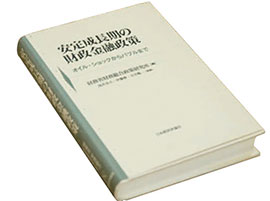
In order for Japanese economics to be richer, I believe it is necessary to conduct substantial research on the following three points: “Basic economic theory,” “Historical and institutional knowledge,” and “Analysis of statistical data.” I feel that the mainstream of current economics is particularly neglecting the second point, and I am rather critical of it. I especially oppose the situation in which the American neoclassical style reigns supreme. With such a theory, I have conducted studies and research mainly on Japanese financial administration. As an example of achievement, I have just started editing the “Heisei Zaiseishi” series – ‘Heisei history of fiscal and monetary policies of Japan’ (after the bubble economy burst). In 2010, “Fiscal and Monetary Policies of Japan” (English version of the postwar “History of fiscal and monetary policies” which has been edited by the Ministry of Finance since the Meiji period, and in which I wrote the Financial Administration section), was completed.
Over 20 members of my laboratory, “Saitama Research Institute for Finance and Economics”, have conducted research, including active financiers who are graduate students. A compiled and published outcome is a book called “Point of Argument in the Bubble Economy and Financial Crisis ” (Nihon Keizai Hyoronsha, Ltd.).
Convey a true picture of the “convoy system” of financial administration and its mechanism to the world
The Ministry of Finance and the Financial Services Agency have edited an official history of administration, “Fiscal and Monetary Policies of Japan” six times since the Meiji period. With a strong demand from overseas for an English version, the first English version of postwar “Fiscal and Monetary Policies of Japan,” comprising two books, was completed in 2010.
I investigated internal information as much as I could at the request of the said Ministry, and wrote a financial administration section for “Showa history of fiscal and monetary policies of Japan”. I also took charge of the English version. I believe I was able to convey a true picture of the “convoy system” of financial administration and its mechanism to the world.

First English version of postwar “Fiscal and Monetary Policies of Japan,” comprising two books
Change in non-regular employees in Korea “Single Status” brought prosperity to Japan by achieving a good balance between productivity improvement and fair benefit distribution through a cooperative relationship between labor and management However, the sluggish growth made management feel that Single Status is a burden. Management shrank the scope of Single Status and created another status outside Single Status. That is, “non-regular” status was created. This “core and periphery” structure of employment also progressed in other countries such as Korea.

Currently, financial institutions that lost their identities through big mergers after the bubble economy burst are locked in a war of attrition in parallel competition. Unless we see a move to take a unique strategy, it is believed that the deadlock status cannot be broken.
Based on this research, I teach front-line financiers in the Graduate School of Economic Science, and published a co-authored book, “Point of Argument in Bubble Economy and Financial Crisis”, as part of achievement.

Graduate School of Humanities and Social Sciences
Professor
Biography
Born on August 6, 1956.
Professor of Graduate School of Humanities and Social Sciences, Saitama University, after being a researcher in the Institute of Fiscal and Monetary Policies at the Ministry of Finance, and Professor of Kanagawa University.
Publications
1995 “Historical structure of Japanese finance,” University of Tokyo Press (The 36th Economist Awards)
2007 “Japanese economy” Chuokoron Shinsho, Inc.
2010 “Point of argument in the Bubble economy and financial crisis” (author and editor) Nihon Keizai Hyoronsha, Ltd


© Copyright Saitama University, All Rights Reserved.